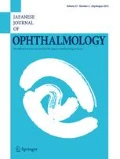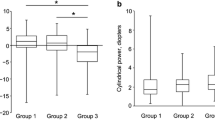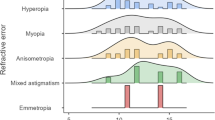Abstract
Purpose
To analyze long-term visual development in children with Down syndrome who received early ophthalmological intervention.
Methods
A total of 125 children with Down syndrome who were examined before 6 years of age and followed up for more than 5 years were selected. Visual development, refraction, visual acuity testing, and the prescription of spectacles were examined retrospectively.
Results
Mean visual acuity by age was as follows: 2 years, 1.13 ± 0.23 logarithm of the minimum angle of resolution (logMAR); 5 years, 0.55 ± 0.25 logMAR; 8 years, 0.27 ± 0.19 logMAR; 11 years, 0.17 ± 0.16 logMAR; and 14 years, 0.10 ± 0.15 logMAR. In 32 children (25.6%), visual acuity reached 0.0 logMAR or better. Hyperopia of +2D or more was observed in 132 eyes (52.8%), and astigmatism of 2D or more was observed in 153 eyes (61.2%). Subjective testing was difficult in many children prior to 4.5 years of age, and grating acuity testing was necessary. Spectacles were prescribed at a mean age of 3.5 ± 1.6 years in 120 children (96.0%). The average duration until the spectacles were worn constantly was 9.0 ± 9.3 months.
Conclusion
Early ophthalmological intervention and longitudinal care is important for children with Down syndrome.







Similar content being viewed by others
References
Wiesel TN, Hubel DH. Single-cell responses in striate cortex of kittens deprived of vision in one eye. J Neurophysiol. 1963;26:1003–17.
Hubel DH, Wiesl TN. Binocular interaction in striate cortex of kittens reared with artificial squint. J Neurophysiol. 1965;28:1041–59.
Tomita K, Tsurui H, Otsuka S, Kato K, Kimura A, Shiraishi Y, et al. Ocular findings in 304 children with Down syndrome (in Japanese). J Jpn Ophthalmol Soc. 2013;117:749–60.
Watt T, Robertson K, Jacobs RJ. Refractive error, binocular vision and accommodation of children with Down syndrome. Clin Exp Optom. 2015;98:3–11.
Kranjc SB. Ocular abnormalities and systemic disease in Down syndrome. Strabismus. 2012;20:74–7.
da Cunha RP, Moreira JB. Ocular findings in Down’s syndrome. Am J Ophthalmol. 1996;122:236–44.
Liza-Sharmini AT, Azlan ZN, Zilfalil BA. Ocular findings in Malaysian children with Down syndrome. Singapore Med J. 2006;47:14–9.
Mohd-Ali B, Mohammed Z, Norlaila M, Mohd-Fadzil N, Rohani CC, Mohidin N. Visual and binocular status of Down syndrome children in Malaysia. Clin Exp Optom. 2006;89:150–4.
Paudel N, Least SJ, Adhikari P, Woodhouse JM, Shrestha JB. Visual defects in Nepalase children with Down syndrome. Clin Exp Optom. 2010;93:83–90.
Creavin AL, Brown RD. Ophthalmic abnormalities in children with Down syndrome. J Pediatr Ophthalmol Strabismus. 2009;46:76–82.
Liyanage S, Bames J. The eye and Down’s syndrome. Br J Hosp Med (Lond). 2008;69:632–4.
Davis JS. Ocular manifestations in Down syndrome. Pa Med. 1996;99:67–70.
Kim JH, Hwang JM, Kim HJ, Yu YS. Characteristic ocular findings in Asian children with Down syndrome. Eye. 2002;16:710–4.
Woodhouse JM, Pakeman VH, Cregg M, Saounders KJ, Parker M, Fraser WI, et al. Refractive errors in young children with Down syndrome. Optom Vis Sci. 1997;74:844–53.
Wong V, Ho D. Ocular abnormalities in Down syndrome: an analysis of 140 Chinese children. Pediatr Neurol. 1997;16:311–4.
Stephan E, Dickson J, Kindley AD, Scott CC, Charleton PM. Surveillance of vision and ocular disorders in children with Down syndrome. Dev Med Ocular Disord Child Neurol. 2007;49:513–5.
Akinci A, Oner O, Bozkurt OH, Guven A, Deqerliyurt A, Munir K. Refractive errors and strabismus in children with Down syndrome: a controlled study. J Pediatr Ophthalmol Strabismus. 2009;45:83–6.
Fimiani F, Lovine A, Carelli R, Pansini M, Sebastio G, Magli A. Incidence of ocular pathologies in Italian children with Down syndrome. Eur J Ophthalmol. 2007;17:817–22.
Ito F, Nakamura K, Hamamura M, Inaizumi R, Shimizu M, Tsutsui A, et al. Refractive management and ocular complications in children with Down syndrome (in Japanese). Jpn Orthop J. 2009;38:177–84.
Berk AT, Saatci AO, Ercal MD, Tunc M, Ergin M. Ocular findings in 55 patients with Down’s syndrome. Ophthalmic Genet. 1996;17:15–9.
Ljubic A, Traikovski V, Stankovic B. Strabismus, refractive errors and nystagmus in children and young adults with Down syndrome. Ophthalmic Genet. 2011;32:204–11.
Bromham JM, Woodhouse JM, Cregg M, Webb E, Fraser WI. Heart defects and ocular anomalies in children with Down’s syndrome. Br J Ophthalmol. 2002;86:1367–8.
Aghaji AE, Lawrence L, Ezegwui I, Onwasigwe E, Okoye O, Ebigbo P. Unmet visual needs of children with Down syndrome in an African population: implications for visual and cognitive development. Eur J Ophthalmol. 2013;23:394–8.
Creavin AL, Brown RD. Ophthalmic assessment of children with down syndrome: is England doing its bit? Strabismus. 2010;18:142–5.
American Academy of Pediatrics (AAP). Children with Down syndrome: health care information for families—healthy children.org. American Academy of Pediatrics; 2015. https://www.healthychildren.org/English/health-issues/conditions/developmental-disabilities/Pages/Children-with-Down-Syndrome-Health-Care-Information-for-Families.aspx. Accessed 10 Dec 2015.
Harris WS, Goodman RM. Hyper-reactivity to atropine in Down’s syndrome. N Eng J Med. 1968;22:407–10.
Nishina S. Prescribing spectacles for infants (in Japanese). Jpn Orthop J. 2009;38:71–6.
Kosaki M. Management of refractive errors in children (in Japanese). J Jpn Ophthalmol Assoc. 1985;56:213–20.
Sato M. Spectacles for toddlers and children (in Japanese). J Eye. 2009;26:741–6.
Courage ML, Adams RJ, Reyno S, Kwa PG. Visual acuity in infants and children with Down syndrome. Dev Med Child Neurol. 1994;36:586–93.
Little JA, Woodhous JM, Lauritzen JS, Saunders KJ. The impact of optical factors on resolution acuity in children with Down syndrome. Invest Ophthalmol Vis Sci. 2007;48:3995–4001.
Morton GV. Why do children with Down syndrome have subnormal vision? Am Orthop J. 2011;61:60–70.
Woodhouse JM, Pakeman VH, Saunders KJ, Parker M, Fraser WI, Lobo S, et al. Visual acuity and accommodation in infants and young children with Down’s syndrome. J Intellect Disabil Res. 1996;40:49–55.
Courage ML, Adams RJ, Hall EJ. Contrast sensitivity in infants and children with Down syndrome. Vis Res. 1997;37:1545–55.
Tsiaras WG, Pueschel S, Keller C, Curran R, Giesswein S. Amblyopia and visual acuity in children with Down’s syndrome. Br J Ophthalmol. 1999;83:1112–4.
Felius J, Beauchamp CL, Stager DR. Visual acuity deficits in children with nystagmus and Down syndrome. Am J Ophthalmol. 2014;157:458–63.
Down’s Syndrome Medical Interest Group (UK). Basic medical surveillance essentials for people with Down’s syndrome. Ophthalmic problems. Nottingham: Down’s Syndrome Medical Interest Group; 2006. http://www.dsmig.org.uk/wp-content/uploads/2015/09/Guideline-vision-revision-2012.pdf. Accessed 10 Dec 2015.
Awaya S. Amblyopia and visual development of infants (in Japanese). Jpn Rev Clin Ophthalmol. 1985;79:1823.
Japan Ophthalmologists Association. Visual development in babies and children. Accessed 10 Dec 2015. http://www.gankaikai.or.jp/health/13/07.html (in Japanese).
Kato K. Refractive error and amblyopia in children. Anisometropic amblyopia and ametropic amblyopia (in Japanese). Jpn Rev Clin Ophthalmol. 1985;79:521–8.
Inoue H. Anisometropic amblyopia, ametropic amblyopia, and meridional amblyopia (in Japanese). Jpn Rev Clin Ophthalmol. 1983;77:1922–31.
Mrak RE, Griffin WS. Trisomy 21 and the brain. J Neuropathol Exp Neurol. 2004;63:679–85.
Benavides-Piccione R, Ballesteros-Yáñez I, de Lagrán MM, Elston G, Estivill X, Fillat C, et al. On dendrites in Down syndrome and DS murine models: a spiny way to learn. Prog Neurobiol. 2004;74:111–26.
Imai M, Watanabe H, Yasui K, Kimura Y, Shitara Y, Tsuchida S, et al. Functional connectivity of the cortex of term and preterm infants and infants with Down’s syndrome. Neuroimage. 2014;85:272–8.
Jacola LM, Byars AW, Chalfonte-Evans M, Schmithorst VJ, Hickey F, Patterson B, et al. Functional magnetic resonance imaging of cognitive processing in young adults with Down syndrome. Am J Intellect Dev Disabil. 2011;116:344–59.
Yang Y, Conners FA, Merrill EC. Visuo-spatial ability in individuals with Down syndrome: is it really a strength? Res Dev Disabil. 2014;35:1473–500.
Couzens D, Cuskelly M, Haynes M. development and Down syndrome: age-related change on the Stanford–Binet test (fourth edition). Am J Intellect Dev Disabil. 2011;116:181–204.
Lea Gratings: 253300. Why do we need to use “cycles per degree”, why not the visual acuity values? Good –lite®; 2004–2016. https://www.goodlite.com/cw3/Assets/documents/253300_GratingPaddle.pdf.
Yago K. Management of refractive errors (in Japanese). Ophthalmology. 2002;44:833–8.
Woodhouse JM, Hodge SJ, Earlam RA. Facial characteristics in children with Down’s syndrome and spectacle fitting. Ophthalmol Physiol Optics. 1994;14:25–31.
Nishina S. Refractive errors in children with developmental delay (in Japanese). J Jpn Ophthalmol Assoc. 2001;72:557–60.
Tomita K, Otsuka S, Tsurui H, Kato K, Kimura A, Tsunoda S, et al. Ocular findings in mentally retarded children excepting Down syndrome (in Japanese). Jpn J Clinical Ophthalmol. 2003;57:515–9.
Haugen OH, Hövding G, Lundström I. Refractive development in children with Down’s syndrome: a population based, longitudinal study. Br J Ophthalmol. 2001;85:714–9.
Stewart RE, Woodhouse JM, Cregg M, Pakeman VH. Association between accommodative accuracy, hypermetropia, and strabismus in children with Down’s syndrome. Optom Vis Sci. 2007;84:149–55.
Cregg M, Woodhouse JM, Pakeman VH, Saunders KJ, Gunter HL, Parker M, et al. Accommodation and refractive error in children with Down syndrome: cross-sectional and longitudinal studies. Invest Ophthalmol Vis Sci. 2001;42:55–63.
Anderson HA, Manny RE, Glasser A, Stuebing KK. Static and dynamic measurements of accommodation in individuals with Down syndrome. Invest Ophthalmol Vis Sci. 2011;52:310–7.
Stewart RE, Woodhouse JM, Trojanowska LD. In focus: the use of bifocal spectacles with children with Down’s syndrome. Ophthalmic Physiol Opt. 2005;25:514–22.
Al-Bagdady M, Stewart RE, Watts P, Murophy P, Woodhouse JM. Bifocals and Down’s syndrome: correction or treatment? Ophthalmic Physiol Opt. 2009;29:416–21.
Nandakumar K, Evans MA, Briand K, Leat SJ. Bifocals in Down syndrome study (BiDS): analysis of video recorded sessions of literacy and visual perceptual skills. Clin Exp Optom. 2011;94:575–85.
Adyanthaya R, Isenor S, Muthusamy B, Irsch K, Guyton DL. Children with Down syndrome benefit from bifocals as evidenced by increased compliance with spectacle wear. J AAPOS. 2014;18:481–4.
Sashima T. Evaluation of visual function in infants with intellectual disabilities (in Japanese). Tokyo: Kazama Shobo; 2009. p. 92–114.
Acknowledgements
I would like to express my gratitude to the entire staff at Heiwa Eye Clinic for their cooperation in conducting the ophthalmological tests and their constant encouragement. I would also like to express my appreciation to Dr. Yoji Takano and the International Medical Information Center for assistance with manuscript proofreading. I would like to thank Editage for English language editing.
Conflicts of interest
K Tomita, None.
Author information
Authors and Affiliations
Corresponding author
About this article
Cite this article
Tomita, K. Visual characteristics of children with Down syndrome. Jpn J Ophthalmol 61, 271–279 (2017). https://doi.org/10.1007/s10384-017-0500-6
Received:
Accepted:
Published:
Issue Date:
DOI: https://doi.org/10.1007/s10384-017-0500-6




